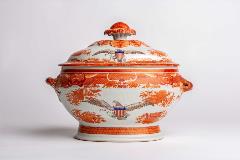Online Exhibits
Arkansas Traveler
The Arkansas Traveler has been many things – including a tune, dialog, picture, certificate, baseball team, boat, and political campaigner – as well as a powerful influence on how people saw Arkansas, and how folks in the state saw themselves.
Beginning in 1840, one rendition of the Traveler was strictly Arkansas-made – an Arkansas Traveler in a humorous dialog with an Arkansas Squatter. They played a tune arranged, at least, by an Arkansas fiddler which became one of the most popular in the American tradition. An Arkansas artist then immortalized the scene in a painting which soon became a popular print. The first three sections of this exhibit talk about these Arkansas-based facets of the Traveler phenomenon.
An out-of-state version took hold at about the same time, an amusing presentation of an outsider’s unpleasant experience in Arkansas. This outsider’s version of the Traveler achieved broad notoriety, and Arkansas came to be seen at the butt of the joke. The state’s image suffered and the Traveler lost favor in Arkansas. Sections IV, V and VI show how the "outsider's" view of Arkansas took hold and the response to it by some in the state.
By the 20th century the stigma of the Traveler faded as the term found use in a wide variety of contexts, including the minor league baseball Travelers and the election campaigners for Bill Clinton. In some ways the old reputation became acceptable again, and the State of Arkansas started presenting Arkansas Traveler Certificates to distinguished visitors. The last two sections discuss these changes in the Traveler.
The history of the Arkansas Traveler is a story of the American frontier, regional stereotypes, and the power of music, a story stretching from our state's earliest days to the present.
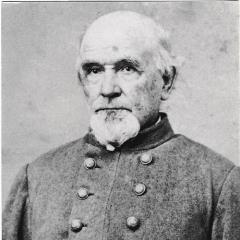 Arkansas artist Edward Payson Washbourne immortalized Sandy
Faulkner’s story by creating a lasting image of frontier America.
Existing in its clearest
form in Leopold Grozelier’s lithograph based upon
Washbourne’s painting, Faulkner’s encounter with the Squatter is
pictured above the melody
line. The print is dedicated to Faulkner. To affirm the
creation as an all-Arkansas project, “designed by one of the natives”
appears before
the dedication.
Arkansas artist Edward Payson Washbourne immortalized Sandy
Faulkner’s story by creating a lasting image of frontier America.
Existing in its clearest
form in Leopold Grozelier’s lithograph based upon
Washbourne’s painting, Faulkner’s encounter with the Squatter is
pictured above the melody
line. The print is dedicated to Faulkner. To affirm the
creation as an all-Arkansas project, “designed by one of the natives”
appears before
the dedication.
No one knows for sure where the original Traveler painting is, though a version of it was donated to the Arkansas History Commission. Another story has the (or a) Traveler painting given to Faulkner. According to his probate inventory, Washbourne left an unfinished “The Turn of the Tune” on his easel at death. Its location is also unknown.
 No one knows for sure who wrote the Arkansas Traveler music. Possibly
the tune appeared in the folk tradition before 1840, and the dialog
presupposes
knowledge of the tune – the Squatter knowing the first half,
the Traveler knowing the first part and the "turn of the tune.” Several
sources
attribute the melody to Jose Tosso of Cincinnati, Ohio, a
concert violinist and composer who was regularly called upon to play
music for "backwoods"
dance.
No one knows for sure who wrote the Arkansas Traveler music. Possibly
the tune appeared in the folk tradition before 1840, and the dialog
presupposes
knowledge of the tune – the Squatter knowing the first half,
the Traveler knowing the first part and the "turn of the tune.” Several
sources
attribute the melody to Jose Tosso of Cincinnati, Ohio, a
concert violinist and composer who was regularly called upon to play
music for "backwoods"
dance.
Sandy Faulkner, the Arkansas Traveler, and Mose Case, an albino African American guitarist and singer, arranged the music for themselves but probably did not compose the tune.
The first known publication of the sheet music in 1847 was "arranged by” William Cumming. (Interestingly it came from Tosso’s publisher who should have known if Tosso wrote it.) In Connecticut by around 1860, the Traveler was a barn dance, featuring a number of calls representing the travels of a peddler from Arkansas.
"The Arkansas Traveler” appeared in early recordings, both cylinder and disk, in the form of a humorous dialog. In 1902 the Len Spencer dialog version became the first song to sell one million records, according to one source. Then the tune itself became the first (or at least one of the first) "country music” songs ever to be recorded, by Eck Robertson and Henry Gilliland in June, 1922. This was among the first fifty recordings selected for the National Recording Registry, founded to preserve significant sound recordings in the United States. The Traveler has been recorded hundreds of times, in traditional, jazz and even symphonic arrangement, proving to be one of the most popular tunes in American history.
Monologue of the Arkansas Traveler by Len Spencer, Edison Records [1902]
Len Spencer (Feb 12, 1867 – Dec 15, 1914) was an elocutionist and recording artist whose performed speeches, skits, and songs. His most successful recording was the Arkansas Traveler, the most popular recording in America in 1902. Charles D’Almaine played the fiddle on the recording.

Monologue of the Arkansas Traveler by Len Spencer, Edison Records [1902]
- Traveler – Why how do you do, boss? What might your name be?
- Squatter (playing the verse of the Arkansas Traveler throughout the performance) – Hey, what made you think I was boss here?
- T – Well, I just guessed it.
- S – Well, guess what my name is. Haw, haw.
- T – Well, how far is it to the next crossroads?
- S – Well, you just follow your nose and you’ll come to it. Haw, haw.
- T – Where does this road go to?
- S – Why it don’t go anywhere. It says right where it is. Haw, haw.
- T – Down the road I saw a horse with a broken leg. Now why don’t you kill it. People generally kill a horse with a broken leg.
- S – Round here we generally kill a horse with a shotgun. Haw, haw.
- T – you’re a pretty smart fellow, ain’t ya?
- S – I ain’t half as smart as my brother Bill.
- T – Who is your brother Bill?
- S – Why my mother’s son, of course. Haw, haw.
- T – Say, I noticed a hole I the roof of your house. Why don’t you get it fixed?
- S – Because it’s been raining lately.
- T – Why don’t you get it fixed when it’s not raining?
- S – When it don’t rain, it don’t leak. Haw, haw.
- T – For pity’s sake, play the rest of that tune, will you?
- S – Now look here. I just reckon there’s no man living smart enough to do that.
- T – Yes there is. I think I can if you let me…Ah, thank you. (Plays the chorus of the Arkansas Traveler.)
- S – Well, by chowder stranger, you’re the smartest man alive, you be. Come right in. Come right in. You can have anything in my place. Come on in. Haw, haw.
 "He has never had the courage to visit Arkansas since."
"He has never had the courage to visit Arkansas since."
The Traveler can give a negative impression of the state if one assumes that the Traveler is from outside Arkansas and the Squatter is a typical local.
The taverns of Salem, Ohio, featured "Traveler as outsider" performances early on, and Jose Tosso of Cincinnati and Mose Case from Buffalo, as well as many other performers, presented it the same way. The Case version is "an Eastern man’s experience among the inhabitants of Arkansas," which ends with the traveler leaving the state, and he "has never had the courage to visit Arkansas since!" This is the tone of the Currier & Ives prints – The Arkansas Traveller and The Turn of the Tune – and of Opie Read’s popular humor journal, The Arkansaw Traveler: humor at Arkansas’s expense.
At one time, each state symbolized the frontier. But Arkansas was on the border of the United States for more than 40 years, carrying an "edge of civilization" image reinforced by the bowie knife or "Arkansas Toothpick," as well as the image supported by the Arkansas Traveler. After the Civil War, when Arkansas hoped to shed the old reputation for something more positive, portrayals of the backwoods nature of the state continued to dominate in the public’s perception.
With the Squatter coming to represent the state, the Arkansas Traveler became humor at Arkansas’s expense, and many self-conscious natives came to see the Traveler as detrimental and quite expensive to Arkansas. One of many boosters of the state in post Civil War period, land developer Theodore B. Mills expressed the opinion that the Arkansas Traveler has been "a curse to the State, the dialogue conveying the impression that the native ‘Rackensacker’ is an idle dog that will never fix his leaking roof in this world."
Published in 1903, the most popular jokebook of all time was named On A Slow Train Through Arkansaw. Though most of the jokes in the book were not about the state, the title assumed that the public would associate Arkansas with humor.
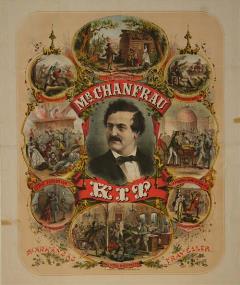 For thirty years Kit The Arkansas Traveller was one of the
most popular plays in America. Opening in Buffalo on April 20, 1869, the
play
debuted to great acclaim in New York City in 1871. Frank
Chanfrau and, later, his son Henry, owned the production and starred as
Kit Redding,
touring until 1899. So popular was the play that it
maintained an annual engagement in Boston from 1872 to 1889.
For thirty years Kit The Arkansas Traveller was one of the
most popular plays in America. Opening in Buffalo on April 20, 1869, the
play
debuted to great acclaim in New York City in 1871. Frank
Chanfrau and, later, his son Henry, owned the production and starred as
Kit Redding,
touring until 1899. So popular was the play that it
maintained an annual engagement in Boston from 1872 to 1889.
Kit began with a version of the traditional dialog between a Traveler and the Squatter and ended with "The Great Bowie-Knife Fight." Tying together two 19th century images of Arkansas – the Traveler and the bowie knife – the drama involved the search for a kidnapped child. Along the way came shooting, gambling, drinking, and robbery, punctuated by an explosion on the steamboat.
While the script portrayed protagonist Kit Redding with a rough nobility, Arkansas retained its negative stereotype by the association of all of those frontier characteristics with the state.
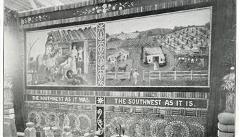 Modern Arkansas in Contrast to the Traveler
Modern Arkansas in Contrast to the Traveler
"As the world imagines us…As we really are."
In one reaction to its negative Traveler image, Arkansans took the opportunity to compare the old with the new. Whether or not the old image was accurate, new Arkansas was wonderful.
This was the theme in the Arkansas display at the 1876 Centennial Exhibition in Philadelphia, where James Fortenbury’s painting of the Traveler decorated a modern setting connecting the state to industry and commerce. The hope was that no one who visited this display could believe that the old Traveler had any relevance, except historical, to present day Arkansas.
"Then" and "now" appeared pinned to the chests of Arkansas Masons at a Boston convention in 1895, on ribbons with the Traveler scene (“As the world imagines us”) above a picture of Little Rock’s modern Masonic Temple (“As we really are”). Civic leaders such as Governor Charles Brough, Historic Arkansas Museum founder Louise Loughborough, and best-selling author Bernie Babcock evoked the Traveler as something to be left in the dust of modern Arkansas.
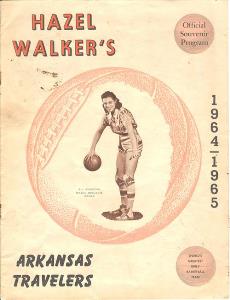 Throughout its history, the Arkansas Traveler name has often been
used without connection to its roots. It became a common term early on,
as a
racehorse in 1849 and a newspaper in Camden, Arkansas, in
1850. The University of Arkansas, Fayetteville, newspaper still has
Traveler on the
masthead. Any number of people from Arkansas have carried
that nickname at one time or another.
Throughout its history, the Arkansas Traveler name has often been
used without connection to its roots. It became a common term early on,
as a
racehorse in 1849 and a newspaper in Camden, Arkansas, in
1850. The University of Arkansas, Fayetteville, newspaper still has
Traveler on the
masthead. Any number of people from Arkansas have carried
that nickname at one time or another.
Several transportation-related products have worn the Traveler label: Arkansas Traveler bicycles made by the Standard Cycle Company of Fort Smith, Traveler children’s wagons were produced in Arkansas, and Arkansas Traveler Boats manufactured in Little Rock. The Arkansaw Traveler is the name of a model of canoe, and the Arkansas Traveler Airline provided commuter service to Memphis in previous decades.
The world of sports is represented with Arkansas Travelers, especially the Little Rock-based Double A franchise, and Hazel Walker's women’s basketball team. Dutch Harrison, Hall of Fame golfer, was known as the Arkansas Traveler.
In the presidential campaigns of 1992 and 1996 Bill Clinton enlisted the aid of a number of friends from Arkansas who called themselves Arkansas Travelers and successfully solicited votes for him around the country.
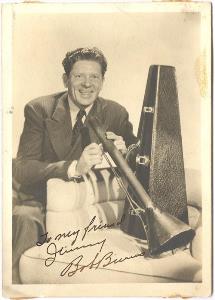 With less concern about its effect on the state's reputation, the
Traveler in some of its old trappings lingered on the periphery of the
state's
life throughout the 20th century.
With less concern about its effect on the state's reputation, the
Traveler in some of its old trappings lingered on the periphery of the
state's
life throughout the 20th century.
For example, well-dressed visitors to Hot Springs were photographed for Happy Hollow postcards, in front of rustic Arkansas Traveler backdrops. Bob Burns, “the Arkansas Traveler,” and the team of Lum and Abner (Chet Lauck and Norris Goff) achieved great success as radio and movie entertainers, basing their gentle humor on the backwoods image of Arkansas. Beginning in 1968, the Arkansaw Traveller Folk Theater in Hardy revived the music, story and image of the Traveler.
In 1941 the Arkansas General Assembly created the Arkansas Traveler Certificate to honor out-of-state visitors, presenting the first one to President Franklin Delano Roosevelt. These Certificates continued the “Traveler as outsider” theme, placing visitors in the role of the Traveler, but by this time the image had lost its power as a regional stereotype, and the Certificate has become a regular feature of gatherings where visitors are honored.
The "backwoods" aspect of Arkansas has now become a positive attraction – the tourism folks tout Arkansas as the Natural State.
https://www.historicarkansas.org/Exhibits/Arkansas-Traveler/interactive-painting
There is nothing on this page.
The Traveler and the Squatter in Dialog
"Halloo, stranger." "Hello, yourself"
Thus begins the Arkansas Traveler dialog. Conversation between two dissimilar individuals is a long-recognized element of the folk tradition. The Arkansas Traveler contrasts a sophisticated Traveler with a Squatter living in humble circumstances.
The Traveler tradition in Arkansas began in 1840, when Sandford Faulkner of Little Rock turned his experience asking directions of a country settler into an entertaining narrative, complete with musical accompaniment. Faulkner became regionally famous for telling the story and fiddling the tune.
One can see in the minstrel shows and the school of Southwestern humor maturing in the 1840s the kind of interaction that Faulkner and others performed in the Traveler. The delight of the story is reconciliation through the language of music, as the Traveler plays "the turn of the tune" (the second half of the music) and receives all the hospitality that the Squatter can muster.
In a way, Faulkner’s story chronicles the end of the frontier in Arkansas, the Squatter being a frontier character of declining numbers as the state’s population grew and matured.
Arkansas Traveller text as performed by Sandy Faulkner
- Traveller – Halloo stranger.
- Squatter – Hello yourself. (fiddling the first part of a tune.)
- T. – Can I get to stay all night with you?
- S. – No, sir, you can’t git to –
- T. – Have you any spirits here?
- S. – Lots uv ‘em; Sal seen one last night by that ar ole hollar gum, and it nearly skeered her to death.
- T. – You mistake my meaning; have you any liquour?
- S. – Had some yesterday, but Old Bose he got in and lapped all uv it out’n the pot.
- T. – You don’t understand: I don’t mean pot liquor. I’m wet and cold and want some whiskey. Have you got any?
- S. – Oh yes, I drunk the last this mornin.
- T. – I’m hungary; havn’t had a thing since morning; can’t you give me something to eat?
- S. – Haint’t a durned thing in the house. Not a mouffull uv meat, nor a dust uv meal here.
- T. – Well, can’t you give my horse something?
- S. – Got nothin’ to feed him on.
- T. – How far is it to the next house?
- S. – Stranger! I do not know. I’ve never been thar.
- T. – Do you know who lives here?
- S. – Yes zir!
- T. – As I’m so bold then, what might your name be?
- S. – It might be Dick and it might be Tom; but it lacks right smart uv it.
- T. – Sir! Will you tell me where this road goes to?
- S. – It’s never gone any whar since I lived here; It’s always thar when I git up in the mornin’.
- T. – Well, how far is it to where it forks?
- S. – It don’t fork at all; but it splits up like the devil.
- T. – As I’m not likely to get to any other house to night, can’t you let me sleep in yours; and I’ll tie my horse to a tree, and do without anything, no eat or drink?
- S. – My house leaks. Thar’s only one dry spot in it, and me and Sal sleeps on it. And that thar tree is the ole woman’s persimmon; you can’t tie to it, ‘caze she don’t want ‘em shuk off. She ‘lows to make beer out’n um.
- T. – Hey don’t you finish covering your house and stop the leaks?
- S. – It’s been rainin’ all day.
- T. – Well, why don’t you do it in dry weather?
- S. – It don’t leak then.
- T. – As there seems nothing alive about your place but children, how do you do here anyhow?
- S. – Putty well, I thank you, how do you do yourself?
- T. – I mean what do you do for a living here?
- S. – Keep tavern and sell whisky.
- T. – Well, I told you I wanted some whisky.
- S. – Stranger, I bought a bar’l more’n a week ago. You see, me and Sal went shars. After we got it here, we only had a bit betweenst us, and Sal she dind’t want to use hern fust, nor me mine. You see I had a spiggin in one eend, and she in tother. So she takes a drink out’n my eend, and pays me the bit for it; then I’d take one out’n hern and give her the bit. Well, we’s getting long fust-rate, till Dick, durned skulking skunk, he born a hole on the bottom to suck at, and the next time I went to buy a drink, they wont none thar.
- T. – I’m sorry your whisky’s all gone; but, my friend, why don’t you play the balance of that tune?
- S. – It’s got no balance to it.
- T. – I mean you don’t play the whole of it.
- S. – Stranger, can you play the fiddul?
- T. – Yes, a little, sometimes.
- S. – You don’t look like a fiddlur, but ef you think you can play any more onto that thar tune, you kin just try it.
- (The Traveler takes the fiddle from the squatter and plays the whole of it.)
- S. – Stranger, tuck a half a duzen cheers and sot down. Sal, stir yourself round like a six-horse team in a mud hold. Go round in the hollar whar I killed that buck this mornin’, cut off some of the best pieces, and fotch it and cook it for me and this gentleman, d’rectly. Raise up the board under the head of the bed, and got the ole black jug I hid from Dick, and gin us some whisky; I know thar’s some left yit. Til, drive ole Bose out’n the bread-tray, then climb up in the loft, and git the rag that’s got the sugar tied in it. Dick, carry the gentleman’s hoss round under the shead, give him so fodder and corn; much as he kin eat. Til. – Dad, they ain’t knives enuff for to sot the table.
- S. – Whar’s big butch, little butch, ole case, cob-handle, granny’s knife, and the one I handled yesterday! That’s nuff to sot any gentleman’s table, outer you’ve lost um. Durn me, stranger, ef you can’t stay as long as you please, and I’ll give you plenty to eat and to drink. Will you have coffey for supper?
- T. – Yes, sir.
- S. – I’ll be hanged if you do, tho’, we don’t have nothin’ that way here, but Grub Hyson, and I reckon it’s mighty good with sweetnin’. Play away, stranger, you kin sleep on the dry spot to-night.
- T. – (after about two hours of fiddling) My friend, can’t you tell me about the road I’m to travel on to-morrow?
- S. – To-morrow! Stranger, you won’t git out’n these diggins for six weeks. But when it gits so you kin start, you see that big sloo over thar? Well, you have to git crost that, then you take the road up the bank, and in about a mile you’ll come to a two-acre-and-a-half corn-patch. The corn’s mityly in the weeds, but you needn’t mind that; jist ride on. About a mile and a half or two miles from thar, you’ll cum to the damdest swamp you ever struck in all your travels; it’s boggy enouff to mire a saddle-blanket. Thar’s a fust rate road about six feet under thar.
- T. – How am I to get at it?
- S. – You can’t git at it nary time, till the weather stiffens down sum. Well, about a mile beyant, you come to a place whar thars no roads. You kin take the right hand ef you want to; you’ll foller it a mile or so, and you’ll find its run out; you’ll then have to come back and try the left; when you git about two miles on that, you may know you’re wrong, fur they ain’t any road thar. You’ll then think you’re mity lucky ef you kin find the way back to my house, whar you kin cum and play on thara’r tune as long as you please.
Life in the Western Country: Arkansaw Territory from 1819-1836
In addition to the ‘dregs of Kentucky and Tennessee,’ western settlement brought discerning ladies and gentlemen from important families, as well as skilled craftsmen and enterprising merchants eager to supply a growing middle class with the latest trends in housewares, textiles, accessories, and more. As industrialized processes gained widespread use in the early 1800s, artisans quickly adapted. Classically trained craftspeople either expanded their product lines and started factories of their own or shifted to retail and repairs. A handful of the most fortunate and profitable continued practicing their arts using traditional methods.
By the second half of the 1800s, shipping by river, road, and rail made almost everything readily available to even the most rural Arkansans. Improvements in industrial technology and mass-production meant items could be constructed cheaply and quickly and sold at reduced prices. These advances increased access to items that previously belonged only to exclusive members of early American aristocracy – descendants of European nobility and barons of capitalist industry. Converging commercial forces created an environment primed for conspicuous consumption: parlors outfitted with fine furniture and china, day dresses of patterned silk, and the flash of a gold pocket watch increased the social prestige of middle- and working-class Arkansans. This exhibit features some of the exceptional objects made, purchased, and flaunted by Arkansans during the Victorian era.
Despite modern misconceptions, 19th century Arkansans were not limited to locally produced goods. Some craftsmen sourced regionally available raw materials like pine, oak, and clay to cut down on the cost of supplies, but by the mid-1820s, shipping by land and by water delivered an array of diverse products to city dwellers and rural farmers alike. Arkansas’s many navigable rivers reduced geographic isolation and allowed mercantile shops to stock their shelves with popular commodities from American river port cities including St. Louis, Cincinnati, and Philadelphia. Shipments through the seaports of New York and New Orleans brought imported textiles, ceramics, silver wares, personal goods, and even skilled craftspeople emigrating from Europe and the United Kingdom. Shoppers could purchase most of their wants and needs directly from area retailers, and they could order hard-to-find items from independent agents or brokers, who served as go-betweens with larger wholesalers.

Corner cupboard
Made by an unknown journeyman
Owned by Narcissa Wilbanks Harrison (1822-1863) and William Graham Harrison (1817-1853)
Conway County, Arkansas
c. 1843
Cherry, pine, and glass
87 x 50 x 27 in.
Gift of Museum of Discovery
Accession No: 2011.11.3
Accomplished journeymen carried tools of their trade as they travelled, preparing themselves for work wherever they went. Oftentimes, traveling craftsmen settled briefly in one area and spent a few weeks or months working in that community. An unnamed journeyman built this corner cupboard for the Harrison family of Conway County in exchange for room and board. Historical sources suggest the artisan apprenticed for three years at a workman’s guild in England, where the rapid adoption of mechanization reduced reliance on skilled labor, forcing craftspeople of all skillsets to relocate to find steady work. From 1820 to 1850, over 15,000 furniture makers advertised their services across Britain and Ireland, each one competition for this anonymous artisan.
The clean lines and durability of this cupboard are a testament to the training and expertise of its maker. The top features cavetto molding, a popular decorative element echoed in the interior curves of the bracket feet at the base. Stiles and rails (vertical and horizontal panels) frame the face of each door, highlighted by the slim beaded edge separating the wood from the glass. The glass itself is fitted with glazing points, a more secure and expensive method of attaching glass than insetting panes within carved grooves. Each of these components combine to compose a cohesive and elegant piece, crafted with precision and care.

Silver pitcher
Made by Adolphe Himmel (1826-1877), for the firm of Hyde & Goodrich (active 1828-1861)
New Orleans, Louisiana
c. 1855
Coin silver
9 ½ x 9 ¾ in.
Arkansas Natural and Cultural Resources Council Grant Purchase
Accession No: 2001.050
New Orleans and New York vied for commercial dominance in the South, with New Orleans well-positioned geographically to fulfill the desires of customers in the entire Mississippi River Valley. Recognizing opportunity, James Hyde (1788-1838) moved a branch of his New York retail enterprise to New Orleans as early as 1817, and his brother-in-law Charles W. Goodrich (1780-1859) joined him in business by 1828. The two men employed silversmiths and watchmakers to create bespoke items for their clientele. Soon, the company was well known for their stock of fine and fancy wares created in-house and imported from the northeastern United States and Europe. For an accomplished silversmith like Adolphe Himmel, working for a distinguished firm like Hyde & Goodrich provided steady commissions and a reliable income as competition between independent artisans and mass-manufacturers became increasingly challenging.
This elegant silver pitcher descended in the family of Chester Ashley (1791-1848), a prominent figure in antebellum Arkansas. One of Chester’s sons, William or Henry, ordered it from Hyde & Goodrich in New Orleans. Handwrought in the Rococo revival style, this ornate pitcher features naturalistic cast silver floral elements and scroll motifs with the Ashley family surname bright-cut in a prominent location on the side of the vessel. It exemplifies the lavish housewares available to affluent Arkansans.
At the beginning of the 19th century, wealthy merchants established factories in New England where businesses and investors prospered. Robust rivers powered water wheels and turbines, and densely populated areas provided labor for factories. Eventually, buyers favored goods produced in these factories over unique, handcrafted items; rather than paying for an artisan’s skill and time, consumers could purchase a product manufactured to look handmade at a fraction of the cost.
Savvy artisans took advantage of mass-production by incorporating prefabricated components into traditionally constructed goods, like employing premade gears when building the inner workings of a clock. Using ready-made parts cut down on an artisan’s manufacturing time and costs, which reduced the price for consumers and enabled some craftsmen to compete with mass manufacturers. However, this strategy did not work for all skilled makers. Many artisans switched from making to repairing, fixing factory-produced goods at a rate cheaper than replacement, while others became shop owners peddling the same type of wares they once created.

Linzel rifle
Schuetzenverein rifle
Made by A.E. Linzel(1831-1904)
Little Rock (Pulaski County)
c. 1870
Half-stock, octagonal barrels, set triggers, walnut stock
53 in. length, approximately .40 caliber
Rhine Condray Sr. Firearms Collection, gift of the Condray Family
Accession No: 89.18.7
Guns originated as a frontiersman's most valuable tool (second only to his knife) for personal protection and for shooting wild game. By the late 19th century, hunting emerged as a leisure activity instead of a necessity, and recreational target shooting transformed rifles from deadly weapons to indicators of style and class. Men gathered in exclusive sporting clubs across the state to boast about their marksmanship skills and compare guns; rifles made by A.E. Linzelwere among the most coveted.
Prussian-born master gunsmith A.E. (August Edward) Linzel left the well-known gunsmithing firm of H.E. Dimick in St. Louis and moved to Little Rock in the years immediately following the Civil War. By 1869,Linzelhad opened a successful shop on Markham Street in the capital city and built a reputation as the state’s most renowned gunsmith. Lavish details like this rifle's ornate trigger guard and curved butt plate, based on the German Scheutzen rifle, act as visual cues separating this firearm from its utilitarian counterparts and were trademarks of Linzel’s designs.
Unfortunately, around the same time, affordable, mass-produced firearms with interchangeable parts flooded the market. These guns were easily repaired by unskilled smiths, and by 1920, only a handful of artisans could still claim to be expert makers and repairers of firearms. To survive, gunsmiths (including Linzel) expanded their businesses to incorporate trades like locksmithing, auto repair, and the retail sale of sporting goods.

Hunter-case pocket watch
Made by Louis C. Bernays (1847-1936)
Little Rock (Pulaski County)
c. 1872
Gold-plated brass and enameled metal
2 ¼ in.
Gala Fund Purchase Honoring Mary Fletcher Worthen
Accession No: 2007.65
After the Civil War, the American economy came to rely on railroads in the same way that river traffic dominated business in the early 19th century. New towns developed around train depots, which eventually functioned as social and commercial hubs for entire communities. In response, consumers embraced pocket watches to keep the time at their fingertips, and jewelers increased their inventory of timepieces to meet demand.
Louis C. Bernays relocated from St. Louis to Little Rock in 1870, where he assisted Albert Cohen at Cohen’s popular jewelry store on Main Street. In 1875, Bernays and an associate, Francis X. Roeck(1838-?), acquired the business and renamed it Bernays & Roeck. Their company advertised an impressive inventory of “Diamonds, Solids, Silverware, Jewelry, Watches, Plated Goods, Clocks, Bisque Figures, Paintings, Engravings, and Novelties,” and proudly announced their stock of merchandise from New York, personally selected by Bernays himself.
Bernays (or one of his employees) constructed this hunter-case pocket watch using a combination of hand-crafted embellishments and prefabricated gears and levers. The watch case is made of gold-plated brass, an affordable alternative to solid gold, stamped with an intricate floral design. It opens to reveal an enameled metal watch face, meant to resemble valuable ivory. Standardized, interchangeable watch parts, first manufactured in 1857, allowed any competent watchmaker to create an accurate, durable timepiece. Shrewd artisan-retailers like Bernays combined items, customized in-house, with an inventory of imported merchandise.
Prior to widespread industrialization, homesteaders and many rural settlers survived by growing and making their own necessities, through trade of basic goods and services, and by living off Arkansas’s rich natural resources -- “the fat of the land.” But consumption of imported luxuries like delicate glassware and fine textiles increased as the price of shipping and production fell. Consumer credit, provided by banks and honored by retailers, eventually permitted customers to buy beyond their means. The growing Victorian middle class took advantage of these developments, adorning themselves and their homes with an abundance of items meant to broadcast taste, wealth, and class, thereby affirming their place in society.
Arkansans stayed informed about trends by consulting popular catalogs, magazines, newspapers, and books. National and international publications advertised the latest furniture and apparel, and they reported on instructions for ladylike comportment and standards for hospitality. Nineteenth-century families entertained guests in the parlor, a more formal version of the modern “living room.” In this hybrid public/private space, Arkansans donned their most fashionable clothing, displayed their fanciest furniture, laid out their finest silver and china, and generally presented themselves to their best advantage.

Morning dress with overskirt and fichu
Maker unknown
Owned by Julia Mary Young Miller
Memphis, Tennessee or New England
c. 1845
Silk, taffeta, bleached cotton and polished cotton
52 x 19 in.
Gift of Juliette Reed Wynn
Accession No: 80.6.8 a-c
Before the proliferation of sewing machines in the 1850s, expert tailors and seamstresses produced most fine clothing. Although women acquired the skills needed to create their own dresses, most hired seamstresses to save time and keep up with their abundant apparel needs. Affluent ladies owned different dresses for different times of day, following the etiquette of the time. This garment is a “morning dress” - meant to be worn while running errands, traveling, or visiting friends during the daytime. Day dresses were typically constructed of lighter fabrics, for breathability, then shaped into dramatic silhouettes that hugged the body and blossomed into voluminous skirts, creating the illusion of a tiny waist. Women favored exotic silks in vivid prints; this dress features striking pink and olive stripes with fringes along all hem lines.
On a family trip to Niagara Falls (circa 1840), sisters Rachel and Agnes Young recalled many “silk bustles,” similar to this frock, deemed “suitable” for daily errands and travels, especially in warmer weather. This particular dress was worn by the Young sisters of Pennsylvania and Delaware during their teenage years in the mid-1830s to 1840s. Rachel (1816-1857), Agnes (1820-?), and Julia Mary Young (1830-1887) most likely shared this dress and simply passed it along as the elder sisters outgrew it. Eventually, Julia the youngest sister, gave the dress to her own daughters.

Tantalus case
Liquor decanters in wooden case
Maker unknown
Probably English
1834-1867
Molded glass decanters with cut glass stoppers in wooden case
11 ¼ x 5 x 12 ¾ in.
Gift of Louise Watkins Wright Loughborough
Accession No: ND23.2 A-D
Victorians nicknamed this clever wooden carrying case after the ancient Greek story of Tantalus, who was punished by the gods to remain hungry and thirsty for eternity, with food and drink just out of his reach. Like the tale, the “Tantalus case” kept refreshment near enough to tempt the parched drinker, but unavailable without a key. This case contains three pressed glass decanters in an ornate cane pattern with cut glass bottle stoppers. During the mid-19th century, manufacturers devised a process to press glass into patterns that closely resembled cut glass, but at a lower cost.
Tantalus cases for liquor decanters gained popularity in England in the late 19th century among the Victorian middle class, who longed to experience the imagined ease and excess of nobility. Using this playful novelty item, the host of a party teased his guests by displaying alcoholic spirits in sparkling pressed glass decanters while maintaining control over the dispensation of drink. The action of unlocking the tantalus case transformed the substance in the decanter into a rare elixir, and those who shared it automatically belonged to an exclusive group. Whether they were conscious of it or not, the owner of the case and the guests he entertained engaged in a brief performance of reciprocal fantasy. Like a child with a miniature china tea set, for a few moments, they acted out the excitement of high-born life.
History in Color
Based on an examination of historical objects, many from the museum’s collection, History in Color explores the spectrum of colors that shaped 19th century cultural attitudes and influenced trends in fashion and décor, the technological innovations that drove the production of brilliant new colorfast dyes and pigments, and the ways early Americans used color to enliven their homes.
It’s easy to understand why many of us believe the historical world was a less colorful place than the present: vivid colors fade, layers of paint flake off, varnish darkens over time, and textiles can become dull from wear. Sepia-toned photographs of the past may fool us into thinking 19th-century Americans either preferred drab colors, or else had limited access to bright pigments and dyes. While it’s true that many pre-industrial colors were not especially permanent, and some were even toxic, a wide range of saturated hues were available for use in the creation of textiles, ceramics, decorative applications, and the fine arts.
Symbolic color has been used to deepen the significance of religious rituals and esoteric ceremonies for thousands of years, and certain colors elicit symbolic connections. In the West, white has long associations with purity, black with death, and red with blood. But however universal these symbolic associations may seem, metaphorical connections with color are rooted in culture and apt to change over time.
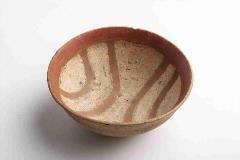 | 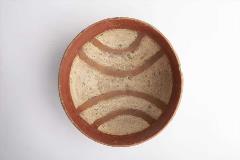 | 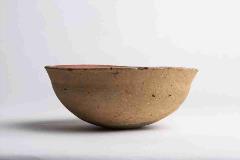 |
Cultural Connections: What colors are seen in Native American pottery from the Southeast?
Native Americans used color in a variety of media such as baskets, clothing, and rock art. Red, white, and black make up the three most common colors in pottery from the Southeast. Red was of particular interest to Native Americans from this region, and it was accessible and easy to use. Color combinations which archeologists call “Nodena Red and White” and “Carson Red on Buff” were also of frequently used. Early potters knew how to repeatedly bring about a desired effect, and they mastered firing methods to produce certain color outcomes. This bowl’s buff color is the result of the manipulation of paste, heat, and oxygen during the firing process. Visible chipped areas on the bowl provide evidence that its clay core is charcoal gray (an indicator that the bowl was fired at a low temperature). By contrast, the bowl’s outer surface is buff, a result of its direct exposure to heat. Essentially—fire—along with an oxygen-rich environment, cleaned this bowl’s outer surface of its organic residues, transforming it from dark gray to a warm buff. The interior of this bowl has a motif comprised of nested “U” shaped bands alternating in red slip and buff surface. The surface was scraped to accentuate the red slip and create a cameo effect. This motif is repeated twice and linked to a red slipped band on the inside of the rim. The people who made this bowl are from a community who also created rock art in the hills overlooking the Arkansas River.
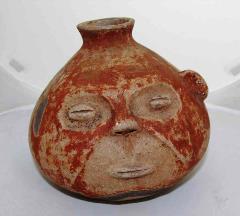 Effigy bottle or “head pot”
Effigy bottle or “head pot”
Possibly made by an ancestor of the modern Quapaw Tribe
Carden Bottoms, Yell County, AR
1350-1600 AD
Carson Red on Buff
Shell-tempered earthenware and mineral slip
8 ¼ x 23 ½ in.
University of Arkansas Museum Collections
Cultural Connections: Who did this red-faced effigy represent?
Native American effigy vessels in the form of plants, animals, and people have been found at sites along the Mississippi River to our east and near the banks of the Arkansas River in the central part of the state. Effigies carry symbolism that archeologists continue to investigate. Bottles depicting the human head are often called head pots, and scholars have long speculated about these decorative vessels and the people they represented. It is not possible to say with certainty if they depicted friends or enemies of the maker.
One explanation goes beyond the literal to suggest that head pots may represent a mythical being known as Red Horn, or “He Who Wears Human Heads As Earrings,” a culture hero and part of a great epic narrative. A culture hero is a mythological character who changes the world through inventions and discoveries. Recent archaeological studies show that some motifs appear across many media, including pottery vessels, rock art, engraved shells, woven baskets, and embossed copper. Archeologists posit a connection between motifs on pottery and those seen in rock art at nearby sites. Rock art found in Arkansas includes at least one example (the “head taker” pictograph) of a human-like being carrying an object that may have been a head. It is possible that this pictograph represents an episode from the epic narrative of Red Horn or a similar mythical being. The repetition of symbols across media and throughout the landscape demonstrates that the use of motifs was not haphazard but intentional and meaningful.
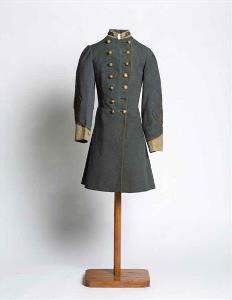 |  | 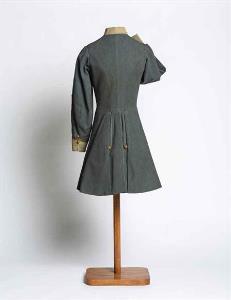 |
Frock coat
Maker unknown
Owned by Captain Berna Blue
ca. 1861-1865
Atlanta, Georgia
Wool
34 ½ x 15 in.
Accession No: 2008.9
Arkansas Natural and Cultural Resources Council Grant Purchase
Cultural Connections: Why is Captain Berna Blue’s uniform different from Colonel Williams’ uniform?
At the onset of the Civil War, many men arrived for war in bright, colorful costumes, but their dress made them easy targets. Even the officers’ golden lace and double-breasted buttons stood out in battle. As casualties mounted, the Confederate Adjutant and Inspector General’s Office issued General Order No. 9, on June 6, 1861, which laid out the proper “Uniform and Dress of the [Confederate] Army.” In this order, officers were ordered to wear “a tunic of gray cloth, known as cadet gray.” Cadet gray was a gray containing a heavy sea-blue pigment with a white thread cross-section. As the war progressed and it became increasingly difficult for the Confederacy to supply uniforms to its troops, men would simply dye whatever clothes they had gray or brown using nuts, leaves, and tree bark, a color that came to be known as butternut.
This hand-stitched Confederate uniform belonged to Captain Berna Blue of Marmaduke’s 18th Arkansas Infantry. A special button hole attached the empty sleeve to the front of his uniform, as Blue’s right arm was amputated after suffering a wound during General Bragg's invasion of Kentucky in 1862. The coat’s material is wool, dyed the standard cadet gray. This uniform was most likely made in a factory in Atlanta, Georgia, after Blue’s exchange as a prisoner of war.

James Harrison Williams (1813-1892)
Samuel Shaver (1816-1878)
Arkansas1861-1862
Oil on canvas
44 x 36 ¼ in.
Accession No: 91.91.1
Gift of David and Margaret England
Cultural Connections: Why is James Harrison Williams wearing a blue uniform?
At the outset of the Civil War, volunteers reported for duty dressed in state militia garb or other military costume that represented the full spectrum in color and in style. Many wore what they brought from home, ranging from vivid holiday uniforms with contrasting colors and local militia gear to older United States blue uniforms. Since many soldiers and officers had homespun, instead of factory-made, uniforms, colors often differed even amongst men in the same regiment. The Confederate States gray, a steel blue color, was deemed the “ideal” gray by the government, but the color was eventually only used by officers. Other soldiers wore cadet gray or butternut colored uniforms.
This portrait of James Harrison Williams depicts the colonel of the 3rd South Carolina Volunteer Infantry Regiment in what was probably his first uniform during the war. By April 17th, 1861, months before the CSA government issued uniform orders, the 3rd SC reported for duty in Columbia, South Carolina, with Colonel Williams as their elected leader. While the date of this portrait is unknown, it depicts Williams donning his colonel’s uniform, with buttons featuring the South Carolina coat of arms up and down the breast. This jacket was painted a deeper blue than the standard cadet gray color.
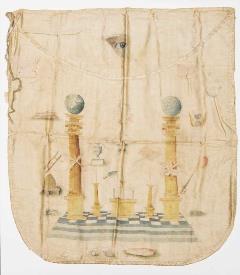
Masonic apron
Belonging to George Alphonso Worthen (1816-1864)
Maker unknown
Likely Little Rock, Arkansas
ca. 1850
Paint on silk with cotton backing
19 ½ x 17 ½ in.
Accession No: 2016.32.1
Gift of Bill Worthen
Cultural Connections: What is the most important color on this Masonic apron?
The ritual apron is the badge of a Freemason, the piece of regalia most essential to the individual Mason’s practice. Free masonry is not a religion, but rather a 300 year-old fraternal organization that teaches a system of ethics and self-improvement. The virtues of Free masonry are illustrated by symbols and veiled in allegory, but their superficial meanings are accessible through hundreds of books published on the subject. Many Masonic symbols illustrate moral interpretations of the stone mason’s traditional tools; the ritual apron is adapted from the full-length leather aprons worn by literal or operative masons, the historical builders of stone structures. Members of the modern fraternity are generally speculative Masons who are charged with building spiritual rather than literal edifices.
Throughout the centuries, white remained the most significant color on the Masonic apron, symbolizing purity of life and reminding its wearer to conduct himself with dignity. By 1800, many ritual aprons were embellished with Masonic symbols; early examples were often hand-painted or embroidered, and eventually printed versions were available, which could then be hand-colored. George A. Worthen’s apron is based very closely on the Masters Carpet design produced by engraver Amos Dolittle for Jeremy Cross’s 1820 publication, The True Masonic Chart, or Heiroglyphic Monitor, a guidebook to the non-secret practices of the brotherhood. The design on this apron was probably printed using a plate based on Amos Dolittle’s original engraving, then hand-painted using moist pan watercolors, which were available in Little Rock from purveyors of stationery like William E. Woodruff at the Gazette office as early as 1836.
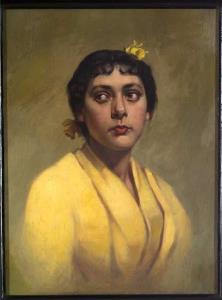 Untitled, Woman in a Yellow Dress
Untitled, Woman in a Yellow Dress
Jenny Eakin Delony (1866-1949)
Paris or New York City
ca. 1890
Oil on canvas
29 ½ x 23 ½ in.
Accession No: 95.79.1
Gift of Irene Morse, Diane Vibhakar, and Len Delony
Cultural Connections: What is the meaning of the color yellow in this painting?
In Western cultures, yellow is frequently associated with happiness and the warmth of the sun, but just as often the color can suggest scandal, sickness, and fear. The last decade of the 19th century was known as the “Yellow Nineties,” an allusion to the yellow covers of salacious French novels. Stodgy Victorian attitudes began to loosen in favor of the French avant-garde; Van Gogh’s Sunflowers blossomed, and one of the era’s most famous writers, Oscar Wilde, was jailed for indecency.
In his 1870 ladies manual, Color in Dress, George Audsley
declared yellow as the color most closely associated with light, and
said its effect on
the mind was cheerful and bright. By the end of the century,
shades of creamy butter and electric lemon became popular color choices
for morning
and day dresses, evening gowns, and seaside attire.The subject
of this portrait is dressed in yellow silk with daffodils tucked into
her hair,
suggesting the arrival of spring. Her short bangs and a hint of
rouge and lipstick indicate a very on-trend ensemble. Despite the
availability
of a variety of pigments by the end of the 19th century,
Arkansas artist Jenny Delony limited her palette to a few tones,
expertly working them
into warm, subtle shades. A green earth background complements
the creamy peach and pink tones in the young woman’s face, while the
radiant yellow
color of her dress appears to light the painting from within.
Among fashion’s enduring traits are a tendency toward the irrational, a penchant for whimsy, and sometimes even a hint of danger. Until the invention of synthetic dyes, bright, colorfast hues were sought after due to their scarcity in the natural world. Color combinations that would be condemned by contemporary eyes as gaudy or garish were embraced by Colonial and Victorian Americans in their choices for apparel and home décor.
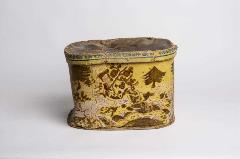
Bandbox
Maker unknown
American
1815-1830
Pasteboard (thin cardboard)
11 ½ x 16 x 13 in.
Accession No: 2017.51.2
Gift of Suzanne Hamilton
Tastemakers and Trends: What is chinoiserie?
Chinoiserie comes from the French word, chinois, for Chinese. The term perfectly illustrates how this design style did not come directly from Asia, but rather is a European interpretation of Asian culture and design. The style originated in the 17th century, at the height of European trade with China and other Asian countries. However, trade with the East could not keep up with the demands of the market, so Western designers created their own “chinois” - inspired pieces. Since these were Westerners’ interpretations of Asian aesthetics, sometimes their own cultural fantasies blended with Asian compositions. This bandbox, a cardboard box used to carry hats and other materials, is a wonderful example of this cultural fusion. At first glance, the hunting scene on the bandbox’s surfaces imulates an Asian print, but a closer look reveals a mix of “foreign” cultures that the American creator simply cobbled together. The scene depicts a classic fox hunt, but the riders are Native Americans shooting bows and arrows instead of upper-class Westerners shooting rifles. These seemingly out-of-place hunters add to the exotic feel of the scene, as does the parrot depicted on the box’s lid.
 |  | 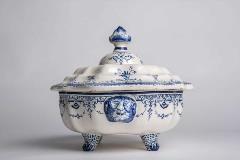 |
Blue tureen
Probably made by the Moustier s potters
France
ca. 1745
Tin-glazed earthenware
10 x 9 ¼ x 13 ½ x
Accession No: 2003.27
Arkansas Natural and Cultural Resources Council Grant Purchase
Tastemakers and Trends: What inspired the designs of French faience?
After Louis XIV banned silver and gold tableware in France in 1672—reserving precious metals for the state treasury to pay for his wars—the French pottery industry subsequently blossomed due to a need for new tableware. To replace the grand tableware of old, faience pottery pieces flooded aristocratic and provincial tables alike. Faience refers to tin-glazed earthenware.
Naturally, since the height of faience pottery was prompted by the seemingly overnight replacement of silver tableware, it makes sense that this new ceramic tableware would mimic the existing popular silver forms. Coinciding with the increasing popularity of Asian porcelain imports, which were too expensive for even most of France’s nobility, French potters decorated their pieces to mimic Asian porcelain in both color (white and blue) and design. Another ban during this period was the import of chintz fabric, from 1686 to 1759. This decorative Indian cotton fabric incorporated motifs of flowers, exotic figures, and insects, woven together with broderie motifs which resembled geometrically arranged panels of drapery. This piece, probably made by the potteries at Moustier-Sainte-Marie, features all of these influences. The shape of the tureen was designed to simulate the silver forms Louis XIV banned. The classic blue and white combination was a direct imitation of imported Asian porcelain. And the hand-painted designs were influenced by both the styles of Asian porcelain and the motifs and patterns from chintz fabrics. Sherds of faience pottery similar to this piece were found at the Post of Arkansas.
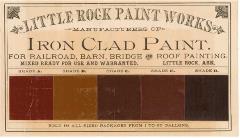
Broadside and trading card
Little Rock Paint & Color Works
Printed by M.R. Savage
Little Rock, AR
ca. 1890
Mineral-based paint on paper
6 ¼ X 16 in.
Accession No: 2017.4
Historic Arkansas Museum Foundation Purchase
Tastemakers and Trends: What was the appeal of this paint store’s product?
Local paint stores of the late 19th century usually sold paint manufactured out-of-state, but Little Rock Paint & Color Works appears to have mixed and made their own paints. This circa 1890s broadside is in mint condition, and features 25 swatches of paint, each color individually painted by hand. The broadside was printed by a local printer, M.R. Savage.
Little Rock Paint Works appealed to its market in several ways: the ‘ready-mixed’ feature would have significantly cut the time a painter spent preparing his paint, especially on larger jobs. The company also boasts itself as the “Manufacturer of the Arkansaw Traveler,” which we speculate is a reference to a paint color cleverly named after the then-ubiquitous pop culture icon. Finally, the fine presentation of 25 richly saturated color samples would have appealed to consumers. The dominant color among these “popular shades and colors” is green, which appears in a dozen varying olive and sage tones, as well as teal and emerald green. Other popular colors include earth tones and a bright and bold orange.
The company’s trading card (a traditional form of advertising) features five color swatches of varying shades of brown and earthy reds. They are advertised on the back of the card as “Iron Clad Paint,” with the suggested use for “Wood or Iron Bridges, Tin and Iron Roofs, Agricultural Implements, Cars, Barns...” Minerals like lead and iron were used in paints for their exceptional binding properties.
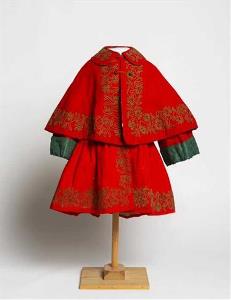
Child’s cape and dress
Maker unknown
Likely Arkansas
ca. 1860
Wool, silk, cotton
26 ½ x 15 in. (dress); 31 ½ x 15 in. (cape)
Accession No: ND171
Tastemakers and Trends: Where did 19th century tastemakers find inspiration for this style?
Flamboyant details borrowed from military uniforms inspired clothing styles for women and children in the mid-19th century. The elaborate braid trim used on European Hussar jackets and a distinctive uniform style used by the French Zouaves became fashion staples in the 1850s and 1860s. The many details of this girl’s sized military-inspired cape and dress closely mimic similar outfits worn by fashionable women of the time. Although this ensemble was likely made in Arkansas, far away from the fashion centers of eastern states, the maker had ready access to current styles of the day through lady’s magazines. Arkansas newspapers of the 1860s advertise wool and braided trim available in a rainbow of colors, giving our seamstress a variety of options available locally.
Today, red and green color pairings are most often associated with the Christmas season, but in the 19th century, tastemakers felt that pairing contrasting colors from the color wheel created visual balance. “Green and scarlet harmonize”, wrote George Audsley in his 1870 book Color in Dress: A Manual for Ladies. Victorians married tones of red and green in their quilts, needlework, clothing, art, and interior decor with striking results. The color red was often used in elegant evening wear and winter coats. It conjured thoughts of energy, emotion, and passion and came into fashion through inspiration from military uniforms and hunting livery. To the Victorians, green evoked a much different response. Green symbolized youth, spring, and calm, and when used as an accent, made a wonderful foil for fiery red.
 |  |
Cupboard
Originally made by Cherokee students
Painted over time by members of the Washbourne family
Russellville, AR
ca.1820-1829
Yellow pine, metal
84 x 62 x 19 in.
Courtesy of the Arkansas Tech Museum
Tastemakers and Trends: Why does this cupboard have a “rainbow” of colors?
This crudely constructed cupboard was made either by members of the Washbourne family and/or Cherokee students at the Dwight Mission, near Russellville (Pope County), Arkansas, around 1820-1829. Frontier furniture was crafted for functionality – which dictated a simple form. And though American interior design continued to evolve with new fads, these essential pieces of furniture were not cast aside, but were instead updated to reflect the tastes of the times.
The paint strips on this cupboard reflect the changing tastes of the American household from its construction date, 1820-1829, to its last coat of paint in 1947. In the 1820s, the exuberant trend of Fancy decoration was at an all-time high. The general rule was to choose pieces and materials that animated an interior. Wood furniture was often constructed out of whatever material was on hand, such as yellow pine, and then painted to mimic another finer wood material, such as mahogany. As new green and yellow pigments became commercially available, these colors were applied to furniture. No colors or combinations were too adventurous. As today, trends waxed and waned. While brown and more sober hues came back into vogue during the 1850s to 1870s, bright and bold colors, such as this green strip, made their return in the late 1870s to 1890s. Neutral colors once again returned to popularity around the turn of the century, and “drab” colors mimicking natural materials, like camel brown, once again dominated the household.
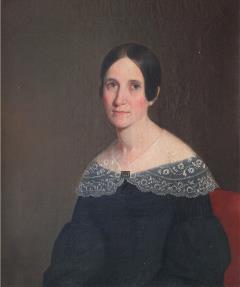 Mrs. John Drennen (née Emily Deadrick Stuart)
Mrs. John Drennen (née Emily Deadrick Stuart)
(1801-1844)
Attributed to George Catlin
Van Buren, Crawford Co., Arkansas
ca. 1834
Oil on linen
38 x 33 in.
Accession No: 2005.12.50
Arkansas Natural and Cultural Resources Council Grant Purchase
Tastemakers and Trends: Why is Mrs . Drennen wearing black?
“Dress” in 19th century terms refers to the total look, from head to toe. “Day dress” was more casual than morning attire, while evening wear or “full dress” was considered the most formal mode. Day dresses were frequently made of colorful wool or cotton prints, but black continued to be popular due to its associations with piety and traditional formal dress.
During the early 19th century when this portrait was painted, true black was a difficult color to produce in textiles. Cheap dyes made of oak galls, walnuts, or blackberries faded almost immediately into orange or dark gray, respectively. The best and most expensive method was triple-dipping (once in blue, yellow, and then red vats of dye). A simpler process combined indigo and a deep red dye from a Central American tree called logwood to create a more permanent, less expensive dark black. In this portrait, Mrs. Drennen wears a black day dress with a low neckline, a pointed bodice, and tight-fitting sleeves that balloon out at the elbow. The 1830s were a transitional decade in fashion, spanning the years between the end of the Regency era and the beginning of the Victorian era. In the early 1830s, ballooning “gigot” or “leg-of-mutton” sleeves were considered fashionable, but by 1836, the gigot sleeve shrank, and the upper sleeve was drawn into tight horizontal rows of puffed shirring. Mrs. Drennen wears an embroidered cotton or linen bertha around her shoulders for modesty, closed with a decorative brooch at the center of her chest.

Overmantle looking glass (mirror)
Maker unknown
Owned by the Woodruff Family of Little Rock, AR
United States
1815-1830
Compo, bole, wood, gold, modern mirror glass
54 ¾ x 44 in.
Accession No: 2018.30
Gift of Swannee Bennett
Tastemakers and Trends: Why are there Romans on this mirror?
The second half of the 18th century in Europe witnessed the rising influence of classical antiquity on aesthetics and artistic style. As artists and aristocrats began touring, and subsequently copying, the great works and monuments of antiquity, the neoclassical style was born. This mix of first-hand observation and the reproduction of classical works dominated European art, architecture, and the decorative arts. Neoclassical designs had an immediate and broad influence on American interiors, and the “antique” taste was utilized by craftsmen in their own creations. To furnish the neoclassical style, ancient forms were transformed into gilt ornament. The gold finish was meant to mimic the golden accents recently rediscovered on Roman ruins. Only the elite were fortunate enough to purchase antiquities to decorate their homes, but cabinetmakers and other artisans transformed their creations to pass as the real things. This mirror is a mix of both.
The bas-relief frieze panel, featuring a scene of Roman centurions riding a chariot drawn by lions, warriors and cherubs, was inspired by classical Roman mythology. This scene is flanked by fluted columns with Corinthian capitals. The gilding of the piece added another mystical element mimicking classical antiquities. Gilding is the application of metal finishes to metal, wood, glass, or ceramics. This frame was probably water and oil gilded onto a bole-prepared compo surface. Compo (composition) was a popular material for molded ornament, as it was faster to produce than carved wood and more stable for gilding.
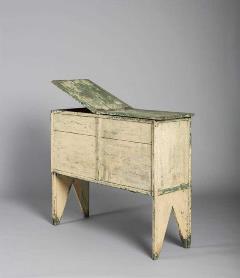
Painted flour bin
Maker unknown
Jefferson or Pulaski County, Arkansas
ca. 1875
Southern yellow pine, paint, iron hinges
36 x 42 ½ x 14 ½ in.
Accession No: 98.11.2
Gala Purchase honoring Ginger and Adron Crews
Tastemakers and Trends: How did the paint on this bin function in a mid-19th century kitchen?
The white paint on this bin oxidized over its original emerald green undercoat, transforming into a crackled yellow-cream. When the museum acquired the piece in 1995, it arrived well-aged, distressed to perfection from over 100 years of use. But back in the 1870s when it was made, its sturdy Southern yellow pine base was given a slick, shiny coat of paint. For a piece so heavily used (it likely stored flour), a freshly painted surface was much easier to wipe down and keep clean than bare wood. This “sanitary aesthetic” factored significantly into mid-Victorian era home furnishings, especially in work spaces like the kitchen.
Sanitary campaigns of the mid-Victorian era promoted hygiene in the home and associated sunlight and brightness with cleanliness. They marked the beginning of a slow shift from the dim, shadowy interiors of earlier days, which were thought to trap dust and conceal germs. The application of paint to surfaces like furniture also conveyed cleanliness and hygiene.
Innovations in paint production helped popularize painted surfaces; as an alternative to traditional oil based paint, which had a more matte finish, 19th century paint manufacturers offered zinc oxide as a non-toxic base with a sheen for enamel paints. A second choice was soft distemper, which was reversible and required a re-coating after a year or two of use.
 Peter Hanger’s velvet parlor carpet
Peter Hanger’s velvet parlor carpet
Manufacturer unknown
Probably American
ca. 1860
Wool and linen
13 x 11 ¼ in.
Accession No: 87.70.17
Gift of Charles and Rebecca Witsell
Tastemakers and Trends: How did 19th-century Americans use carpets to enliven their decor?
Few original 19th century carpets survived the ravages of moths, water damage, heavy foot traffic, and efforts to repurpose even the most worn fragments. This well-used carpet section was found in the attic of the historic Frederick Hanger House at 1010 Scott Street in Little Rock with a hand-written inscription penned by Frances Marion Hanger, daughter-in-law of early Arkansas settler Peter Hanger, describing the carpet’s origins. In 1859, Peter Hanger acquired 160 acres east of downtown Little Rock, as well as a Greek Revival home that he called Oakwood, which was located on what is now the south side of the 1400 block of East 9th Street. According to Frances’s inscription, Peter Hanger ordered several thousand dollars’ worth of goods during the Civil War, but this velvet carpet was the only article in the order to make it down the Mississippi River before it was blockaded by Union Troops in 1863.
Velvet carpet is a high-end tapestry carpet with a low pile. Most middle-class families used flat-woven ingrain carpet, but affluent homes were decorated with pricier carpets, including Wiltons, Brussels, Axminsters, and tapestries. Wills and estate inventories confirm the practice of reserving quality floor coverings for the most public rooms of a house, with the best carpet saved for the formal parlor where guests were entertained and weddings, funerals, and other events were held. This velvet carpet was probably installed wall-to-wall in the parlor of Peter Hanger’s antebellum home, Oakwood. The original colors would have included cream, orange, maroon, golden yellow, and brown in an arabesque design.

Reproduction ingrain carpet
Brunschwig & Fils, New York
Wool 22 x 20 in.
Reproduced in 2004
Based on 1840s carpet from Abraham Lincoln’s home in Springfield, IL
Accession No: R2005.002
Tastemakers and Trends: Is this carpet gaudy or tasteful?
“Two colors only, with the dark and light shades of each, will make a very handsome carpet,” wrote “Miss Leslie” in her 1854 edition of The Lady’s House Book. Mid-19th century American design critics like Leslie praised ingrain carpets with various shades of green and red. Although this carpet may seem gaudy to contemporary eyes, the pairing of red and green was especially popular in the 1840s and 50s, in home furnishings and fashion alike. It is no accident that on the color wheel, red and green lie opposite each other and are thereby considered complementary.
A home-furnishings fever spread across America when this ingrain carpet was manufactured. For the first time, Americans were experiencing an age of public taste in which they could actively cultivate an aesthetic for their home. Thanks to mass production, now most people—not just the wealthy few—could afford to decorate their interiors. Wallpaper, carpeting, and furniture arrived in Little Rock on steamboats from factories in Cincinnati and New Orleans.
The average Arkansas settler probably grew up in a home with bare or painted pine floors. But by the 1840s, almost everyone could afford to deck his home wall-to-wall with carpet. Samples arrived in mail-order catalogs, and merchants offered goods in great variety in their storefront windows. Given this new opportunity, a person might enthusiastically choose carpet bursting in colors and geometric patterns. The antebellum home of James McVicar (located on the museum grounds) features this reproduction carpet in the parlor.
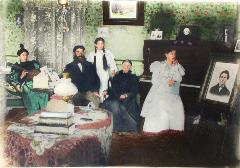 |  |
Roderweis front parlor
Photographer unknown
Jacksonville, AR
1895
Photographic print
9 x 11 in.
Accession No: 96.49.3
Gift of the Estate of Ina Dupree
Tastemakers and Trends: What colors do you imagine in this Victorian parlor?
The Roderweis family (pictured) represented the up-and-coming, stylish middle class of late 19th century Americans. John Roderweis, the head of this German immigrant family and a carpenter by trade, built his home and surely beamed with pride at this accomplishment. His family fittingly posed for the camera inside their fully-furnished front parlor, the heart of the home. The family displays some of its prized personal possessions, including a piano, Bible, and gilt-framed family portraits. It’s the kind of cluttered, romantic nest that characterized so many bourgeois Victorian homes.
It’s hard to tell from the original black-and-white photograph that this late 19th century Victorian parlor was full of color, from floor to wall to tabletop. But a closer examination shows that nature-inspired floral and vine-like patterns climb almost every surface and furnishing. Cozy chaos came to define Victorian interiors. Attention to scale and a warm, subdued color palette helped harmonize an otherwise dizzyingly cluttered living space. Design critics from the period praised wallpaper and carpet manufacturers’ use of soft or “drabbed” color combinations, and denounced the bold contrasting colors of the mid-19th century. A wall covering, for example, was not meant to be a showstopper, but rather contributed to the atmosphere of a room.
We reimagined the Roderweis parlor with the help of William Doran, a professional colorist who digitally applied color to a high-resolution scan of the print. The tones in our retouched image appear a bit louder and bolder than they would have looked in real life, which is a trait common to both modern and historical photo colorizations.
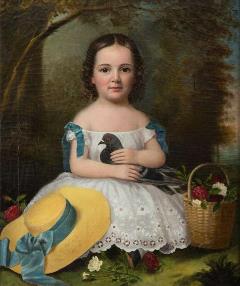 Abbie Churchill Henry C. Byrd (1804-1884)
Abbie Churchill Henry C. Byrd (1804-1884)
Little Rock, Pulaski Co., Arkansas
ca. 1857
Oil on mattress ticking
42 ¼ x 37 ½ in.
Accession No: 98.51.1
Gala Fund Purchase in honor of Adron and Ginger Crews
Technology and Innovation: How have the fine art painter’s tools changed since the 1850s?
When artist Henry Byrd made this portrait of young Abbie Churchill in the late 1850s, the painter’s tools and techniques had not changed much since 1400s, but American and European artists were poised on the precipice of rapid technological development. Before the overwhelming adoption of the collapsible paint tube, invented in 1841, each pigment was ground into linseed or poppy seed oil using a glass muller on a stone slab. For the sake of economy, most artists made only enough paint for the day’s work, laying out just a few colors on a relatively small palette.
Standing at his easel, the 19th-century artist needed a solid foundation in draftsmanship, but he also had to remember a dizzying number of rules governing the possibilities and limitations of each pigment. Some pigments could not be worked with oil, and many pigments created chemical reactions when mixed, altering colors and even eating away at the linen support. Wax, alum, chalk, and other drying agents were added to correct what were seen as deficiencies in each pigment’s intrinsic properties. Itinerant artists like Henry Byrd probably would’ve purchased raw pigments and other fine art supplies from a merchant like S.H. Tucker, a Little Rock dealer in a wide variety of dry goods and stationery shipped to Arkansas through contact with wholesalers in bigger port cities like New Orleans. In lieu of fine linen canvas from England, Byrd painted this portrait on a support of tightly-woven blue and white mattress ticking.
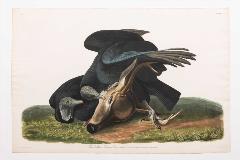 Black Vulture or Carrion Crow
Black Vulture or Carrion Crow
Drawn from nature by John James Audubon (1785-1851)
Engraved, printed and colored by Robert Havell
London
1831
Double elephant folio
37 x 47 in.
Accession No: 93.34
Gift of Dr. Alex A. Pappas
Technology and Innovation: How were colored prints made for Audubon's original The Birds of America?
Before the invention of photography and precision-ground lenses, if you wanted to study birds closely, you needed to be handy with a rifle. American naturalist John James Audubon was interested in the fledgling field of ornithology from a young age, and he spent hundreds of hours shooting and sketching wild birds. To create life-like poses, he pinned a freshly-killed bird to a board of his own design, wiring it into place and working quickly with pencils and watercolor before the creature deteriorated beyond use.
Almost from the beginning, Audubon was determined that even the biggest birds he drew should be reproduced at life-size. When printers Robert Havel l and his son were hired, they used the largest paper then available, the double elephant folio. Robert Havell Jr. first created a copperplate engraving based on each of Audubon’s original drawings by incising the design into a sheet of copper with a sharp tool called a burin. Then he inked the entire copper plate and wiped it clean, so black ink remained only within the incised lines. A printing process called aquatint was used to create effects like texture and value. Color printing was in its infancy in the 1830s, so once the black lines were printed, color was added by hand using watercolor paints. Robert Havell Sr. created one perfect ‘pattern’ print that was copied over and over by a team of colorists who painted each print to match the reference pattern.
 | 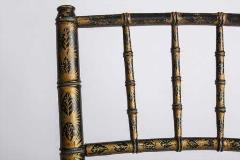 |  |
Black Japanned chair
Maker unknown Likely American
19th century
Maple or pine with fabric cover over original rush seat
32 x 14 ½ in.
Accession No: 73.11.7
Gift of the Elger Estate
Technology & Innovation: Why was this chair painted gold and black?
Fueled by increasing trade with countries like Japan and China in the 18th and 19th centuries, Europeans and Americans developed a taste for all things Asian. The love for "Oriental" imports included art, ceramics, textiles, and perhaps most of all, black lacquered furniture. Lacquer finishes were prized for their lustrous depth and striking black sheen and those who could afford it incorporated imported pieces into their home decor. Yet for many people, high price and limited supply meant that authentic lacquered furniture was out of reach.
Lacquer is made of carefully processed sap from the Chinese lacquer tree, which is a species Western craftsmen didn't have access to. Ever ingenious, they developed ways to replicate the glossy black finish by using varnishes, a product derived from plant resin. Cabinet makers and furniture decorators called their faux-lacquered furniture “japanning”; the mistaken view of the time was that “Japan” encompassed all of southeast Asia, India, and China. This process further imitated imported furniture by incorporating faux bamboo, floral, porcelain elements, and gilt chinoiserie designs. Fine black lines, referred to at the time as pen work, were applied to further enhance the lacquer designs.

Crazy quilt square
Maker unknown
Arkansas
ca. 1890
Silk, velvet and cotton
9 ¼ x 10 ½ in.
Accession No: 2003.4.120
Gift of Peg Newton Smith
Technology and Innovation: How did a Victorian quilter have access to such a wide variety of fabrics?
A Victorian-era crazy quilt square holds a myriad of 30 unique pieces of fabric. Velvets in chocolatey earth tones and silks in pale pink and crimson red are accented by yellow and white embroidery stitches. Composed of a household’s clothing and textile remnants, this crazy quilt square is a wonderful way to see the variety of fabrics available to Americans during the second half of the 19th century. Mail-order design books such as Godey’s an d Journal of Design offered Americans the latest fabric samples, from patterned cottons and calicoes to high-styled silk, chiffon and crepe for fine dresses. For the first time, Americans (not just the wealthy elite) could purchase textiles of varying colors, patterns, and textures.
The industrialization of textiles in this country during the 19th century provided Americans with an unprecedented abundance of affordable fabric. Manufacturers in major cities produced fabrics like silk, velvet, and cottons in varying colorful prints. This new found supply essentially gave rise to the pieced quilt in America. In particular, crazy quilts—which got their name from the seemingly random arrangement of fabric pieces—appealed to needle workers of all skillsets and economic means. The crazy pattern was widely adored for the chance it gave its maker to add personal touches such as memorial ribbons and personal initials, and to make use of her “rag bag” of dress and household textile remnants.
 “Currant” Flock Paper for General Purposes
“Currant” Flock Paper for General Purposes
Manufactured by Woollams and Co.
The Journal of Design
England
1850-51
Flock paper, paint
5 x 4 in.
Accession No: 87.68.2
Technology and Innovation: What toxic ingredient created green in early Victorian wallpaper?
Victorians fell in love with a particular color called “Scheele’s Green,” named after the Swedish chemist, Carl Wilhelm Scheele, who first developed it. But the secret ingredient used to make this lusted-for hue was arsenic, an extremely toxic naturally-occurring element mined and used by manufacturers to color paint, wallpapers, and clothing. Arsenic was blamed for the deaths of miners and many consumers who were exposed to this pigment through painted objects and home furnishings like wallpaper.
Arsenic is a metalloid, meaning it and can bind with another metal to form an alloy, or a compound mixture. Scheele first combined arsenic in the 1770s with copper when he produced his brighter-than-usual green pigment. The copper-to-arsenic ratio, along with the degree of heat applied during the bonding process, determines the intensity of the resulting green. Even though arsenic was used as a rat poison at the time, consumers and manufacturers continued to deny its toxic effect on humans. However, as number of arsenic-related illnesses and a deaths rose, manufacturers eventually stopped using it in their production.
Machine printed-wallpaper entered the mass market after 1840. Mechanized rollers allowed manufacturers to produce a higher volume of paper, making wallpaper more accessible and affordable to middle class Americans than traditional block-printed wallpaper. Rococo revival floral patterns were especially popular during the first half of the 19th century.
-(1).tmb-medium.jpg?sfvrsn=410254af_4) |
|
Orange Tureen
Maker unknown
Canton, China
ca. 1810
Glazed hard-paste porcelain
11 ½ x 14 ½ x 8 ¾ in.
Accession No: 2006.45.1
Gift of Mr. and Mrs. A. Howard Stebbins, III.
Technology and Innovation: How was this tureen made?
Chinese porcelain, “chinaware,” has always been popular in America. In 1785, when America’s firs t merchant ship in the Chinese trade returned from Canton, her hull contained the porcelain pieces made to order for the American market. The mechanics of the porcelain trade with the West was a streamlined, multi-step process completed at several different locations. From the digging of clay, the forming of objects at a potter’s wheel or using a mold, the decorating and glazing, the firing of kilns, to the final packing and distributing of the items to merchants, this process was automated at different villages established for each individual step.
At Canton, the vessels received final decorations specified by their buyers. Traders shared designs and personalized emblems from their customers with the painters who masterfully copied these designs. While visiting Canton in 1769, American traveler William Hickey noted, “we found upwards of a hundred persons at work in sketching or finishing the various ornaments upon each particular piece of ware, some parts being executed by men of a very advanced age, and others by children even so young as six or seven years.”
This tureen features the Fitzhugh, an immensely popular pattern of the time, with a floral quadrant of chrysanthemum clusters spaced around a central field which was filled with the buyer’s own design. The orange over-glaze, with a personalized emblem of the rampant United States bald eagle, painted en grisaille (dark brown over-glaze enamel painted to present an appearance with more shades) is an extremely rare combination.
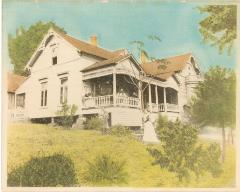 Roderweis family outside their home
Roderweis family outside their home
Photographer
unknown
Jacksonville, AR
ca. 1880
Photographic print and watercolor
10 ½ x 11 ½ in.
Accession No: 96.49.2
Gift of the Estate of Ina Dupree
Technology and Innovation: Why did this late 19th century family have their photograph color-tinted?
When the Roderweis family posed before their home circa 1890, innovators in the field of photography had not yet figured out how to feasibly process color photographs. Still, it’s fair to say that everyone yearned to see their lives captured in color. The photography industry’s solution was (for only a few pennies more) to colorize the black and white prints by hand.
After they were processed, the photographic prints were tinted by a “colorist,” a trained professional usually hired by the photographer. It was common for the photographer to make color notes on the back of his print for the hand-tinter to use as her guide. The colorist applied her colors with a small brush, using pastel, oil, or watercolor. Varnishing the print first ensured an even application of the color medium.
The colorizing of Roderweis’s print was perhaps a bit of an amateur job, or the family chose a minimal but affordable treatment. The artist brushed the principal elements of the image: the ground (grass & vegetation), the roof of the home, and a big blue sky. The five members of the Roderweis family remain untouched, and stand in their original black and white forms.
Pigments are colored powders that can be suspended in a medium like oil, egg, or acrylic to make paint. The primary difference between pigments and dyes is that pigments don’t dissolve – tiny particles of color stay suspended in the medium. Dyes are mostly used for coloring textiles, and they dissolve in water. Dyes usually need to be fixed with a mordant so the color doesn’t wash out of the fabric. Pigments generally cannot be made into dyes, but some dyes can be made into paints by fixing them onto a white mineral powder like clay. Paints made from dyes are called lakes.
Stitched Together
Quilting is not an American invention, but a skill carried to the New World by immigrants. However, in the almost two and a half centuries since the colonies became states, quilting evolved into a uniquely American tradition represented by the proliferation of block style designs. Most early quilts were not the thrifty creations of hard-strapped settlers, but elegant, complex compositions that commemorated significant life events and were reserved for the family’s best bed. It is rare to find an Arkansas quilt that pre-dates 1850; the majority of surviving 19th century quilts were produced in the last quarter of the century by the hard-working wives and daughters of independent yeoman farmers. Despite the demands of daily life, many Arkansas women found time to create some of the most exquisitely crafted quilts in the entire country. This exhibit tells the story of quilting in Arkansas through a selection of the museum’s most treasured bed covers.
Quilting is a democratic art, a creative skill that can be
performed on any level to produce everything from utilitarian bedding to
complex, ambitious works of art; since the founding of this country,
Americans of every race, gender, religion, and socio-economic status
made and used quilts. Before the Industrial Revolution, women were
closely associated with the domestic production of textiles and
needlework in this country. Whether she was taught to read or write,
almost every young girl began to learn basic sewing techniques from her
mother and older sisters by the time she was two or three years old, and
she continued to use and improve upon those skills for the rest of her
life. Four-and-nine patch quilts were simple enough for children and
novices, while other patterns required the precise arrangement of
thousands of pieces, a feat best suited for the most accomplished
needleworker.

Nine Patch
Pieced quilt
Sarah Everett
1879-90
Huntsville (Madison County)
64.5 x 92 in.
Collection of Historic Arkansas Museum
Loughborough Trust Purchase
Accession No: 80.17.1
The nine patch is the quintessential American quilt. This pieced
pattern offered beginners and masters alike a design they could complete
with
satisfaction. Three-on-three squares, identical in size, are
arranged in block formation and repeated. Still, even the simplest
patchwork required
the quilter to make a series of thoughtful choices, such as
color, texture, the arrangement of squares, and scale of the blocks.
That this
basic arrangement of squares could produce an infinite
variety of results is testimony to the nine patch’s universal appeal.
Popular variations
include the four patch and 16 patch.To make her quilt, Sarah
Everett alternated between square cut-outs of three cotton fabrics she
had readily
available, in brown and madder rose wool, and a blue and
white fabric which may have been woven by hand. While hers is not the
prettiest or
finest of quilts, its pleasing but prudent quality speaks to
the 19th century frontier spirit, and the accessibility of this
functional art
form.
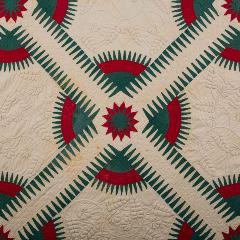 |  |  |
Rocky Mountain Road
Pieced quilt with stuffed work or trapunto
Elizabeth Rogers Manning and Martha Manning
ca. 1860
Arkadelphia (Clark County)
100 x 98 in.
Collection of Historic Arkansas Museum
Gala Fund Purchase
Accession No: 92.5.3
A pattern of many names, this quilt tells the story of westward migration in antebellum America. Known variously as “New York Beauty,” “Crown of Thorns,” “Indian Summer,” and “Rail through the Mountains,” this pattern evolved to become “Rocky Mountain Road” as Americans reached the western states. It is a wonderful example of how pattern names changed to fit the new experiences of antebellum America. Whatever name it was given, this pattern put even the most experienced quilter’s skill and patience to the test. Thousands of tiny triangles were painstakingly cut to needle-fine points, and arranged, piece by piece, to form an overall saw-tooth design. Bold, contrasting colors give a dramatic effect, as well as the added stuffed work or trapunto vines in the whitework, which acts as a foil to the geometry of the pieced work.
A unique sisterhood bound the earliest of American quilts. In the
late 18th and early 19th centuries, most young women learned a
rudimentary degree of needlework skills from the older women in her
family. The occasional but relished quilting bee or frolic offered the
isolated farm woman a chance to socialize with her peers and exchange
ideas about patterns and techniques. At these merry gatherings, women
assisted a neighbor with the final stage of binding her quilt’s three
layers: top, batting, and back.Friendship and album-style
quilts enlisted multiple people—friends, church members, civic club
members—to work a single quilt together over an extended time. Such
collectively created works were typically made over a series of day-long
sessions at a hosting member’s house (with plenty of opportunities for
socializing and meals provided), and the final finished piece perhaps
sold at a charitable fundraiser or presented as a gift to a loved one
departing from the community. Log Cabin
Log Cabin
Pieced quilt
Clara Baker
ca. 1950
North Little Rock (Pulaski County)
78 x 63 in.
Collection of the Historic Arkansas Museum
Gift of Rebekah Teague
Accession No: 2004.68
Clara
Baker was affectionately called "Mother Baker” by those who knew her.
Born on a cotton farm near Memphis around 1917, she was part of a great
migration of African Americans who left the poverty and hardship of the
Mississippi Delta after World War I. Baker was fond of bold, bright
colors and made use of fabric remnants she had at her disposal, from
hospital sheets to old articles of clothing. She was a resourceful woman
who sewed her own clothes, and was accustomed to getting by on very
little. It was her habit to offer her quilts to those who visited her at
her home in North Little Rock.
Also known as “britches”
quilts, Baker’s quilt falls into a category of utilitarian quilts made
by poor white and African American women of clothing and blanket
remnants during the first half of the 20th century. Despite the use of
well-worn fabrics like corduroy, polyester, and seersucker, Baker’s
quilt expresses her creativity, resourcefulness, and love for color.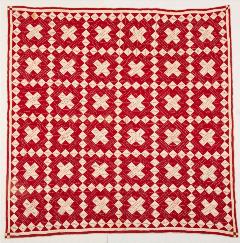 Signature
Signature
Pieced quilt
Made by members of the Women’s Home Missionary Society of Cabot
1907
Lonoke County
79.25 x 79.25 in.
Collection of Historic Arkansas Museum
Gift of Carolyn Park
Accession No: 2012.032
Members of a missionary society in Cabot (today’s First United Methodist
Church), probably made this quilt to raise money for their new church
building. Signature quilts like this one often generated
funds through the donation of money by each individual named on the
blocks, and in
the final sale, or raffling of the quilt. More than 1,000
names record a large network of the people and organizations who touched
the lives
of this early 20th-century Arkansas community.
Mrs. Vise, a descendent of one of the quilt’s makers,
recalled that her father, who wrote with “such a pretty hand,” first
applied the names
to the quilt in pencil or chalk, over which her mother and
other skilled members embroidered by hand. Vise recalled, “I remember my
grandmother
fussing about the way some of the members did their
stitches—not making them small enough, you know, and of course some of
the knotted
ends shouldn’t have been left to show.”
An enslaved woman’s needlework skills often included sewing,
knitting, crocheting, embroidery, tatting, spinning, weaving, and
quilting. Enslaved seamstresses typically produced all the clothing for
male and female slaves, plus quilts, coverlets, and table linens for the
master’s house. Many enslaved people made utilitarian and decorative
quilts for their own use, stitched at night after the day’s tasks were
complete, and quilts for the big house, created under the supervision of
the mistress of the household. Very few slave-made quilts exist today;
fire, theft, and sale for extra income contributed to their
disappearance, but frequent use was probably the most important factor.
Without documentation of a quilt’s origin, it is impossible to know if
it was made by an enslaved artisan. Occasionally, quilts made by
enslaved people for the master’s household were considered among a
family’s best quilts, and they were tucked away for use on special
occasions. These are the most common surviving quilts made by enslaved
artisans.
Chintz Appliqué
Pieced and appliquéd quilt
Made by enslaved individuals owned by Caleb Lindsey
c. 1838
Pulaski and/or Jefferson counties
104 x 103 in.
Collection of Historic Arkansas Museum
Gala Fund Purchase honoring Peg Newton Smith
Accession No: 95.53
 |  |
According to family lore, enslaved individuals owned by the Caleb Lindsey family made this quilt for the 1838 marriage of Rebecca Brilhart to Caleb Lindsey Jr. In 1840, Pulaski County Census records indicate that Caleb Lindsey Sr. owned eight women and employed two free black individuals. This rare chintz appliqué medallion quilt generally predates pieced block style quilts that became popular in the third quarter of the 19th century. Chintz appliqué quilt tops were made by cutting figures like flowers or animals from glazed, (in this case roller-printed) cotton chintz fabric and stitching them to a piece of foundation fabric. American and European quilts made before 1840 were often organized around a central medallion design that featured piecework or appliqué, or both. The central focus of this quilt is a geometric piecework and appliqué design framed by multiple pieced borders. By 1850, whole-cloth and appliqué techniques were almost completely eclipsed by the emerging popularity of repeating block style quilts in America.
From cradle to coffin, 19th century quilts were made to mark the
most significant events in a family, such as the birth of a new baby, a
marriage, or the loss of a loved one. Cherished as keepsakes, quilts
often get passed down the generations. The occasions for which the
quilts were made get passed down, too, in pattern names like “Grandad’s
Wedding Quilt” or “Mother’s hope chest quilt.”
Today,
quilters still bring their ancestors’ quilts to guild meetings to share,
and many of them learned needlework from their own mothers and
grandmothers. A tangible connection to their family’s heritage, the
textiles are also a source of pride; when a historical quilt is donated
to a museum, it sometimes comes with a handwritten note pinned to the
top, denoting the year, maker, and bits of genealogy. Many such
treasures were kept safe over decades in blanket chests, smelling of
cedar chips.
 | 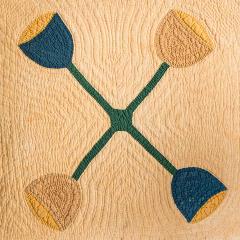 |
Star of Bethlehem and unknown foliate pattern
Pieced and appliquéd quilt
Mary Jane Vincent
ca. 1860
Searcy (White County)
74 x 73 in.
Collection of Historic Arkansas Museum
Gift of Nona V. Ogle
Accession No: 88.47
A tradition in the Vincent family was for the mothers in the family to
christen their baby’s birth with a newly made quilt. True to this
custom,
Mary Jane Vincent completed her Star of Bethlehem on the
night her son was born, in 1860. The quilt stayed in the Vincent family
well into
the late 20th century, until the dying days of the family’s
last heir, Nona (Ogle) Vincent. In 1988, Vincent mailed the quilt to the
museum
with a letter that read: “I am sending my father’s quilt in
your care… If you like the quilt, please keep it and restore it, I am 81
years of age, my health is no good, I will not be able to
keep it much longer. I am the last one of the immediate family.”
An expansion on the central medallion concept of earlier
quilts, the star begins in the center, and thousands of diamond-shaped
cutouts emanate
to the quilt’s outermost edges. The prismatic effect of this
pattern is believed to have been influenced by the invention of the
kaleidoscope
in the early 19th century.
The everyday experiences of 19th century women are reflected in the colloquial names of their patterns, as well as the representational motifs that adorned their finished quilts. They used appliqué to imitate nature with stylized flowers, leaves, and vines, while pattern names like Broken Dishes, Puss in the Corner, Shoo Fly, and Hole in the Barn Door reflect daily life on the farm. Quilt-making reached fad status in the second half of the 19th century as Americans shaped a national identity distinct from their ancestors. This era has been called the most visually inventive time period in the history of quilting; almost all of the quilt styles popular today were conceived between 1870 and 1910. Inspiration for quilt designs came from diverse sources including fashionable furniture and decorative arts, popular inventions, and cultural exchanges made possible by the proliferation of international publications and expositions.
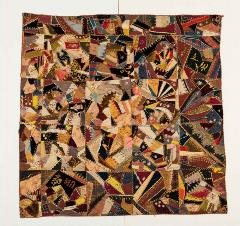 Crazy
Crazy
Pieced quilt
Made by Rose family dressmaker
ca. 1880Little Rock (Pulaski County)
66 x 64 in.
Collection of Historic Arkansas Museum
Gift of Peg Newton Smith
Accession No: 2003.4.115
America’s infatuation with “Oriental” art began in 1876 at the Philadelphia Centennial Exposition, where some nine million people visited the Japanese Pavilion. The asymmetrical designs introduced there influenced the spectrum of American decorative arts, but especially appealed to textile designs, in the form of the “crazy quilt” pattern. Cuts of velvety soft earth tones and shiny silks were seamed together with brightly colored embroidery stitches. Eastern motifs like fans and figures in kimonos were popular, as well as other Victorian symbols such as butterflies, daisies, and peacock feathers.
This quilt belonged to the prominent Rose family of Little Rock. Their dressmaker made beautiful use of the formal garments she had sewn for the family’s special occasions. Over the years, members of the Rose family gazed at the quilt and recalled “Ellen’s debut dress,” “Emma’s trousseau gown,” and other fine remnants from which the crazy quilt was made. Certain embellishments make this quilt a sentimental family scrapbook of sorts, such as the initials “U.M.” for Uriah Milton Rose (1834-1913), the family’s figurehead and founder of Rose Law Firm.
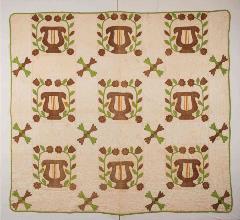 Lyre
Lyre
Pieced and appliquéd quilt
Elizabeth Anne Washington Rogers
ca. 1860
Arkadelphia (Clark County)
77 x 83.5 in.Collection of Historic Arkansas Museum
Gala Fund Purchase
Accession No: 91.90.1
Symbols of ancient Greek life were revived in American furniture, ceramics, and other decorative arts during the 18th and 19th centuries. During this period, Greek symbols became associated with classical artistic achievement and democratic ideals. In Greek mythology, Apollo is the god of sun, music, poetry and art. One of his instruments is the lyre, whose harp-like quality symbolizes harmony and heavenly peace.
More commonly seen in furniture and vases, the lyre motif is somewhat rare in quilts. But because of its popularity, it comes as no surprise that this symbol would also surface in the textile arts. This Arkansas quilter chose to embellish her quilt’s nine lyres with appliquéd tulips and roses of her own design. Like so many Americans of her time, Rogers embraced the classical ideals of peace and harmony when furnishing her home.
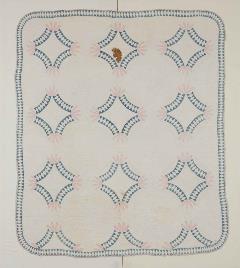 Whig's Defeat or Democratic Victory
Whig's Defeat or Democratic Victory
Pieced and appliqued quilt
Marian Aikman Trayler
ca. 1850
Izard County
79.25 x 67.5 in.
Collection of Historic Arkansas Museum
Gift of Dula Mariah Wood Hook
Accession No: 95.76
The genius of Mariah Aikman Trayler’s quilt lies in her use of negative space. Upon closer examination, it is evident that Trayler began her quilt with 10 individually pieced squares (plus two half-squares), each consisting of blue-and-white diamond borders, and four pink petals augmenting the corners. Each pieced square was then appliquéd to the quilt top, to form an overall circular design. Trayler quilted the whitework with the finest and most intricate stitches.
Like written documents, historical quilts can function as primary
sources, yielding information about their makers. Well before they won
the right to vote in 1920, women used quilting to express their
political and social views. Pattern names like Whig’s Defeat, Abe
Lincoln’s Log Cabin, and Grandmother’s Choice (a women’s suffrage
pattern) describe moments in American political history, while special
embellishments like embroidered verses or the names of political
candidates could be used to illustrate a quilter’s personal position.
Quilts also provided useful ways to raise money to support religious
causes, social reform movements, and war efforts. During the Civil War,
patriotic women on both sides of the conflict took up their sewing
needles and quilted to raise funds for ill-equipped soldiers. On many
occasions during the war, quilts were used as graphic political
statements, and some were considered dangerous enough to suppress or
destroy.
Secession
Pieced quilt with trapunto
Mary Green McPherson
ca. 1861
West Point (White County)
85.5 x 97 in.
Collection of Historic Arkansas Museum
Gift of Florence C. Spore (Mrs. Kenneth L.)
Accession No: 85.39.4
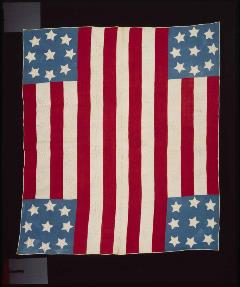
Mary McPherson of West Point, Arkansas, made her quilt to
raise funds at a local raffle for Confederate soldiers in need. But far
from a humble bed covering, the masterpiece she created was also a
political statement, as herninetrapuntostarssymbolize Arkansas as the
ninth state to secede from the Union. When word got out about
McPherson’s “rebel quilt,” Union soldiers put her under house arrest
until the war’s end. In later newspaper accounts, it was said that
McPherson’s quilt stayed hidden as it passed hands from plantation to
plantation, and attic to cellar.
Trapuntoisan ornamental
technique used separately or in combination with all-white, pieced and
appliquéd quilting. McPherson’s stuffed stars give her quilt a wonderful
three-dimensional quality. To make them, she cut tiny slits in the
quilt’s backing, stuffed in bits of cotton batting, and then carefully
stitched closed the openings. Applyingthetrapuntowouldhave been the
final intricate step of completing her quilt.

